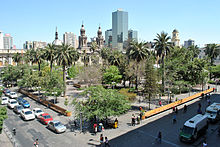Plaza de Armas
The Plaza Mayor , often Plaza de Armas in Latin America , is the regularly laid out main square of numerous cities in the Castilian crown . The expression “Plaza Mayor” is explicitly found in an ordinance of the “Catholic Kings” from 1480 as a market square , on which the town hall of the city is also to be located. The Spanish founding of cities in Latin America followed this plan, the expression "Plaza de Armas" also referred to the square as a meeting point ( roll call point ) in the event of a military attack. Other important public buildings such as the main church and arsenal were also built here. (In this sense a decree from Philip II from 1576).
The naming of the corresponding places varied with time and the political economy. Many have been renamed Plaza Real or Plaza de la Constitución . An important part of political life took place here, bullfights and festivals were held here.
The aesthetic ideals of the Renaissance played a role in the creation of these large, regular city squares. After a city fire, for example, the Plaza Mayor of Valladolid was regularly rebuilt in 1561, the planner was Francisco de Salamanca .
Today's use
The Plaza de Armas is nowadays usually elaborately decorated with flowers, shrubs and often wells. The most important buildings of a city (church, municipal administration, town hall, palace of justice, bank and post office) can be found there, bars, discos and restaurants are also popular and invite you to stroll. Depending on the tradition, on certain days, e.g. On Saturdays, for example, the plaza is full of people running their laps around the square while they talk, which in Spanish is called dar una vuelta " going around ". In many cities, various political and social groups meet on Sundays to hoist the state flag and sing the national anthem, often in military style in uniform and standing at attention.
Examples
- Plaza de Armas , Manila
- Plaza Mayor , Salamanca
- Plaza de Armas , Santiago de Chile
Individual evidence
- ↑ Las Plazas Mayores en España , article by ÁNGELA MARÍA MARTÍNEZ VILLEGAS (Spanish) ( Memento of the original from October 5, 2013 in the Internet Archive ) Info: The archive link was inserted automatically and has not yet been checked. Please check the original and archive link according to the instructions and then remove this notice.
See also
literature
- Teresa Avellanosa: Plazas Mayores De España ; Madrid, 2000, ISBN 8487507875
- Miguel Antonio Rojas: La plaza mayorel urbanismo, instrumento de dominio colonial , Barcelona 1978, ISBN 84-7264-006-X



